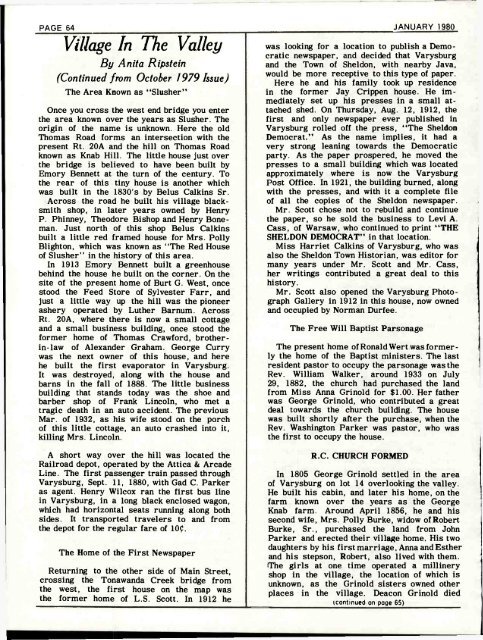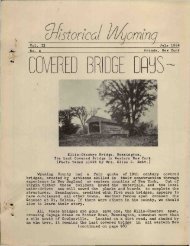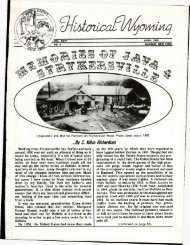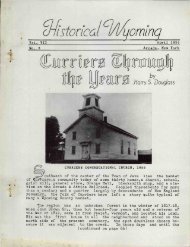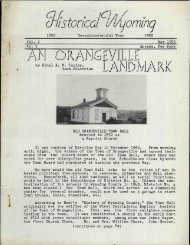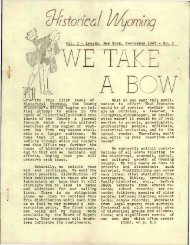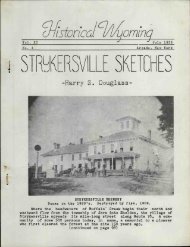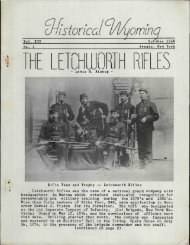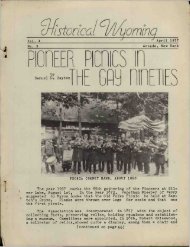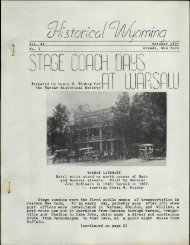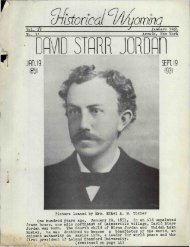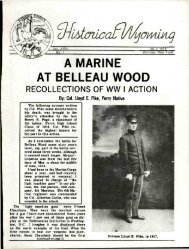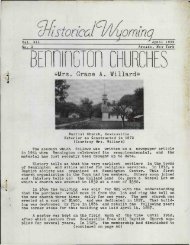Historical Wyoming County Jan 1980 - Old Fulton History
Historical Wyoming County Jan 1980 - Old Fulton History
Historical Wyoming County Jan 1980 - Old Fulton History
Create successful ePaper yourself
Turn your PDF publications into a flip-book with our unique Google optimized e-Paper software.
PAGE 64<br />
Village In The Valley<br />
By Anita Ripstein<br />
(Continued from October 1979 Issue)<br />
The Area Known as "Slusher"<br />
Once you cross the west end bridge you enter<br />
the area known over the years as Slusher. The<br />
origin of the name is unknown. Here the old<br />
Thomas Road forms an intersection with the<br />
present Rt. 20A and the hill on Thomas Road<br />
known as Knab Hill. The little house just over<br />
the bridge is believed to have been built by<br />
Emory Bennett at the turn of the century. To<br />
the rear of this tiny house is another which<br />
was built in the 1830's by Belus Calkins Sr.<br />
Across the road he built his village blacksmith<br />
shop, in later years owned by Henry<br />
P. Phinney, Theodore Bishop and Henry Boneman.<br />
Just north of this shop Belus Calkins<br />
built a little red framed house for Mrs. Polly<br />
Blighton, which was known as "The Red House<br />
of Slusher" in the history of this area.<br />
In 1913 Emory Bennett built a greenhouse<br />
behind the house he built on the corner. On the<br />
site of the present home of Burt G. West, once<br />
stood the Feed Store of Sylvester Farr, and<br />
just a little way up the hill was the pioneer<br />
ashery operated by Luther Barnum. Across<br />
Rt. 20A, where there is now a small cottage<br />
and a small business building, once stood the<br />
former home of Thomas Crawford, brotherin-law<br />
of Alexander Graham. George Curry<br />
was the next owner of this house, and here<br />
he built the first evaporator in Varysburg.<br />
It was destroyed, along with the house and<br />
barns in the fall of 1888. The little business<br />
building that stands today was the shoe and<br />
barber shop of Frank Lincoln, who met a<br />
tragic death in an auto accident. The previous<br />
Mar. of 1932, as his wife stood on the porch<br />
of this little cottage, an auto crashed into it,<br />
killing Mrs. Lincoln.<br />
A short way over the hill was located the<br />
Railroad depot, operated by the Attica & Arcade<br />
Line. The first passenger train passed through<br />
Varysburg, Sept. 11, 1880, with Gad C. Parker<br />
as agent. Henry Wilcox ran the first bus line<br />
in Varysburg, in a long black enclosed wagon,<br />
which had horizontal seats running along both<br />
sides. It transported travelers to and from<br />
the depot for the regular fare of 10£.<br />
The Home of the First Newspaper<br />
Returning to the other side of Main Street,<br />
crossing the Tonawanda Creek bridge from<br />
the west, the first house on the map was<br />
the former home of L.S. Scott. In 1912 he<br />
JANUARY <strong>1980</strong><br />
was looking for a location to publish a Democratic<br />
newspaper, and decided that Varysburg<br />
and the Town of Sheldon, with nearby Java,<br />
would be more receptive to this type of paper.<br />
Here he and his family took up residence<br />
in the former Jay Crippen house. He immediately<br />
set up his presses in a small attached<br />
shed. On Thursday, Aug. 12, 1912, the<br />
first and only newspaper ever published in<br />
Varysburg rolled off the press, "The Sheldon<br />
Democrat." As the name implies, it had a<br />
very strong leaning towards the Democratic<br />
party. As the paper prospered, he moved the<br />
presses to a small building which was located<br />
approximately where is now the Varysburg<br />
Post Office. In 1921, the building burned, along<br />
with the presses, and with it a complete file<br />
of all the copies of the Sheldon newspaper.<br />
Mr. Scott chose not to rebuild and continue<br />
the paper, so he sold the business to Levi A.<br />
Cass, of Warsaw, who continued to print "THE<br />
SHELDON DEMOCRAT" in that location.<br />
Miss Harriet Calkins of Varysburg, who was<br />
also the Sheldon Town Historian, was editor for<br />
many years under Mr. Scott and Mr. Cass,<br />
her writings contributed a great deal to this<br />
history.<br />
Mr. Scott also opened the Varysburg Photograph<br />
Gallery in 1912 in this house, now owned<br />
and occupied by Norman Durfee.<br />
The Free Will Baptist Parsonage<br />
The present home of Ronald Wert was formerly<br />
the home of the Baptist ministers. The last<br />
resident pastor to occupy the parsonage was the<br />
Rev. William Walker, around 1933 on July<br />
29, 1882, the church had purchased the land<br />
from Miss Anna Grinold for $1.00. Her father<br />
was George Grinold, who contributed a great<br />
deal towards the church building. The house<br />
was built shortly after the purchase, when the<br />
Rev. Washington Parker was pastor, who was<br />
the first to occupy the house.<br />
R.C. CHURCH FORMED<br />
In 1805 George Grinold settled in the area<br />
of Varysburg on lot 14 overlooking the valley.<br />
He built his cabin, and later his home, on the<br />
farm known over the years as the George<br />
Knab farm. Around April 1856, he and his<br />
second wife, Mrs. Polly Burke, widow of Robert<br />
Burke, Sr., purchased the land from John<br />
Parker and erected their village home. His two<br />
daughters by his first marriage, Anna and Esther<br />
and his stepson, Robert, also lived with them.<br />
The girls at one time operated a millinery<br />
shop in the village, the location of which is<br />
unknown, as the Grinold sisters owned other<br />
places in the village. Deacon Grinold died<br />
(continued on page 65)


